Table of Contents
Sleep deprivation is a big problem in America. About 1 in 3 people don’t get enough sleep. Learning how to fall asleep fast is key in today’s stressful world.
Getting good sleep is essential, not just a luxury. Most adults need at least 7 hours of sleep each day. Finding ways to beat insomnia can help you sleep better and feel better.
This guide will show you how to fall asleep quickly. It includes methods backed by science. These tips can help you sleep better, whether you have trouble sleeping sometimes or all the time.
We’ll look at many ways to improve your sleep. From relaxing techniques to changing your sleep environment, we’ve got you covered. By using these strat egies, you can make your sleep better and improve your life.
Quick Picks: The best sleep products to help you fall sleep quickly
[lasso id=”26″ link_id=”268″ type=”table”]
1 Understanding Sleep Science and Sleep Latency
Sleep is a complex process that involves many mechanisms. It shows how quickly we fall asleep. Sleep latency, the time it takes to fall asleep, is key to understanding sleep quality.

The science of sleep onset is fascinating. It shows how our body’s natural rhythms work. A healthy sleep latency is between 10 and 20 minutes, showing we’re ready to sleep.
What Defines Normal Sleep Latency
Normal sleep latency is the time it takes to fall asleep. Research shows:
- Taking less than 10 minutes might mean we’re sleep-deprived
- Falling asleep in 15-20 minutes is a sign of good sleep health
- Exceeding 20 minutes could signal sleep disorders
Factors Influencing Sleep Onset
Many things affect our sleep and latency, including:
- Stress levels
- Environmental conditions
- Physical activity
- Diet and caffeine consumption
- Electronic device usage
The Intricate Science of Falling Asleep
The brain goes through amazing changes when we fall asleep. Neurochemical changes help us move from wakefulness to sleep. This includes decreased brain activity and increased melatonin production.
Sleep is not merely a passive state, but an active neurological process involving complex physiological mechanisms.
Understanding sleep latency helps us spot sleep challenges. It lets us find ways to improve our rest. By watching our sleep patterns and making changes, we can better our sleep and well-being.
2 The Military Method for Rapid Sleep
The military sleep technique was created by Olympic coach Lloyd Bud Winter for the United States Navy Pre-Flight School. It’s a fast sleep method that helps people fall asleep in under two minutes. This method has become popular for its quick and effective way to overcome sleep challenges.
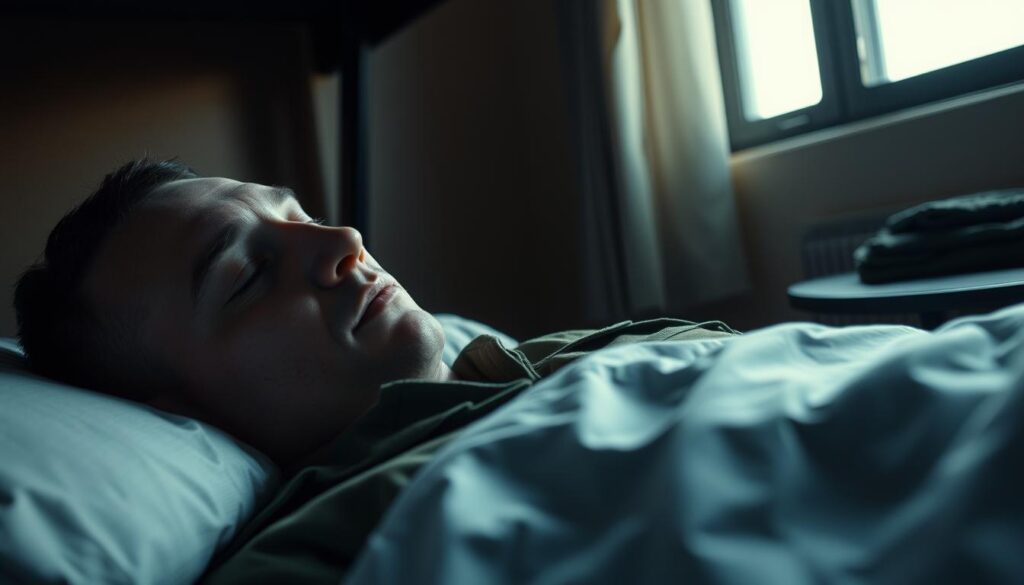
The military method is not just a sleep strategy. It’s a detailed approach to relaxation that has been scientifically perfected. Studies show that 96% of pilots could fall asleep within 10 minutes after practicing this technique for six weeks. This success rate shows the power of this sleep method.
Key Components of the Military Sleep Method
- Progressive muscle relaxation techniques
- Controlled breathing exercises
- Mental visualization strategies
- Systematic body relaxation process
“Sleep is a weapon, and mastering it can transform your performance.” – Military Sleep Training Philosophy
The military sleep technique involves a specific sequence of physical and mental steps to calm the nervous system quickly. Deep breathing is key in triggering melatonin production and reducing stress. These are crucial for fast sleep onset.
| Sleep Statistic | Percentage |
|---|---|
| Adults with Occasional Insomnia | 20% |
| Sleep Onset Insomnia | 15% |
| Average Time to Fall Asleep | 20-30 Minutes |
Learning this fast sleep method takes consistent practice. Experts suggest dedicating six weeks to learn and use the technique every night. By mastering these relaxation strategies, people can improve their sleep quality and overall well-being.
3 Creating the Optimal Sleep Environment
Making your bedroom the perfect place for sleep is key. It’s not just about looks; it’s about science. Creating the right conditions for rest is essential.

Your bedroom’s role in sleep is huge. Studies show that your environment can greatly affect your sleep.
Temperature Control Strategies
Temperature is vital for a good night’s sleep. The ideal range is 60 to 67 degrees Fahrenheit. At 65 degrees, most people sleep best.
- Maintain room temperature between 60-67°F
- Use breathable bedding materials
- Consider a programmable thermostat
- Use fans or cooling devices if needed
Lighting Management
Light affects your sleep a lot. Blue light from screens can cut melatonin by up to 50%. This messes with your natural sleep rhythm.
- Use blackout curtains
- Minimize electronic device usage before bedtime
- Install dimmer switches
- Use warm, low-intensity lighting in evenings
- Use blue light blocking computer glasses
[lasso id=”9″ link_id=”164″ type=”table”]
Noise Reduction Techniques
Managing noise is key for good sleep. About 70% of people say noise really affects their sleep.
- Use white noise machines
- Employ earplugs
- Seal windows to reduce external sounds
- Consider soundproofing techniques
Bedding and Comfort Optimization
The right bedding can improve sleep by up to 30%. Choose a comfy mattress, supportive pillows, and quality sheets.
- Replace mattress every 7-10 years
- Choose pillows supporting proper neck alignment
- Use breathable, natural fiber sheets
- Wash bedding regularly to reduce allergens
[lasso id=”7″ link_id=”165″ type=”table”]
“Your bedroom should be a sanctuary designed for rest and recovery.” – Sleep Experts
By using these strategies, you can make your bedroom a sleep haven. It will help you sleep faster, deeper, and better.
4 How To Fall Asleep Quickly Using Breathing Techniques
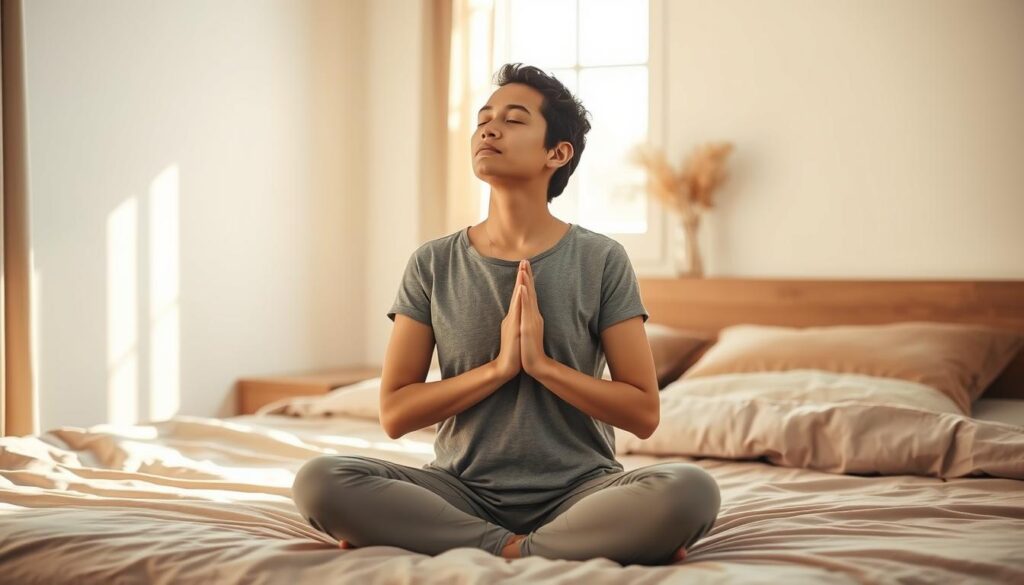
Breathing exercises can change your sleep routine. They calm your mind and get your body ready for sleep. This makes falling asleep easier.
The 4-7-8 breathing method, created by Dr. Andrew Weil, is great for sleep. It uses yoga principles to relax you naturally.
“Breathing is the first act of life and the last. Our very life depends on it.” – Elizabeth Brown, Sleep Scientist
Here are some breathing techniques to help you sleep faster:
- Box Breathing: This involves equal counts of inhaling, holding, exhaling, and pausing.
- Diaphragmatic Breathing: It’s deep breathing that strengthens the diaphragm.
- Alternate Nostril Breathing: This balances the nervous system.
Studies show these techniques work. A 2017 review found Bhramari pranayama breathing lowers breathing and heart rates fast. A 2013 study showed nasal breathing exercises cut stress levels.
Using these techniques can cut sleep start time by 10-15 minutes. They help activate the parasympathetic nervous system. This tells your body it’s time to relax and sleep.
Consistency is important. Make these breathing exercises part of your bedtime routine. This way, you’ll see better sleep quality.
5 Progressive Muscle Relaxation Method
Discovering a good muscle relaxation technique can change how you handle stress and sleep. Progressive Muscle Relaxation (PMR) is a powerful way to release tension and relax deeply. It’s backed by science and helps manage stress, improve sleep, and lower anxiety.

PMR was developed in the 1930s. It involves tensing and then releasing muscle groups. Studies show it has many benefits:
- Reduces anxiety levels by up to 50%
- Improves sleep quality
- Lowers blood pressure
- Alleviates various types of pain
Step-by-Step Muscle Relaxation Guide
To relax muscles effectively, follow these steps:
- Find a quiet, comfortable space
- Start with deep breathing
- Begin at your toes and move up
- Tense each muscle group for 5 seconds
- Release and feel the tension go away
“Relaxation is not a destination, but a journey of understanding your body’s signals.” – Sleep Wellness Expert
Common Mistakes to Avoid
When trying to relax, people often make mistakes. Don’t rush or force it. Consistency and patience are crucial for mastering relaxation.
Most people can do a PMR session in 10-15 minutes. It’s a simple way to reduce stress and improve sleep.
6 Mindfulness Meditation for Better Sleep

Sleep meditation is becoming a key tool for fighting sleep disorders. About 35% to 50% of adults worldwide struggle with insomnia. Mindfulness techniques are seen as a natural way to enhance sleep quality.
Studies show mindfulness meditation is effective. A 2018 meta-analysis of 18 trials found it improves sleep quality. These benefits can last from 5 to 12 months after starting.
“Mindfulness is not about perfection, but about creating a calm mental space that invites restful sleep.”
Mindfulness techniques offer several sleep benefits:
- Reduction in stress and anxiety
- Increased melatonin and serotonin production
- Lower heart rate and blood pressure
- Improved overall mood and mental focus
Starting with simple sleep meditation is easy. Begin with 5-10 minute sessions focusing on breath and body relaxation. People often see a 30% boost in sleep quality with regular practice.
[lasso id=”8″ link_id=”166″ type=”table”]
While mindfulness meditation is promising, it’s important to remember it’s not a replacement for good sleep habits. To improve sleep, combine meditation with regular sleep times and a good sleep environment.
“The quieter you become, the more you can hear.” – Ram Dass
About 70% of young adults face sleep issues. Mindfulness meditation is a powerful, easy way to boost sleep health and overall well-being.
7 The Power of Visualization Techniques
Sleep visualization is a strong mental tool to help you sleep better. It uses guided imagery to relax your mind. This can change your bedtime routine and make you sleep better.

Studies show that mental relaxation can help you fall asleep faster. About 25% of Americans struggle with insomnia. So, using visualization is key.
Guided Imagery Exercises
Guided imagery creates peaceful scenes in your mind. This calms you down and gets your body ready for sleep. Try these:
- Imagine a serene beach with gentle waves
- Visualize a tranquil forest with soft, rustling leaves
- Picture a peaceful mountain landscape
- Create a calm, comfortable personal sanctuary
“The mind is everything. What you think, you become.” – Buddha
Creating Mental Scenarios
Creating good mental scenes takes practice and patience. Use all your senses to make it real. Sensory details like sound, texture, and temperature can make it more relaxing.
A study in “Applied Psychophysiology and Biofeedback” found that visualization can lower stress. It’s all about repeating it and making it your own.
Adding sleep visualization and guided imagery to your bedtime can reduce stress. It helps quiet your mind and makes sleep easier.
8 Sleep-Inducing Foods and Beverages
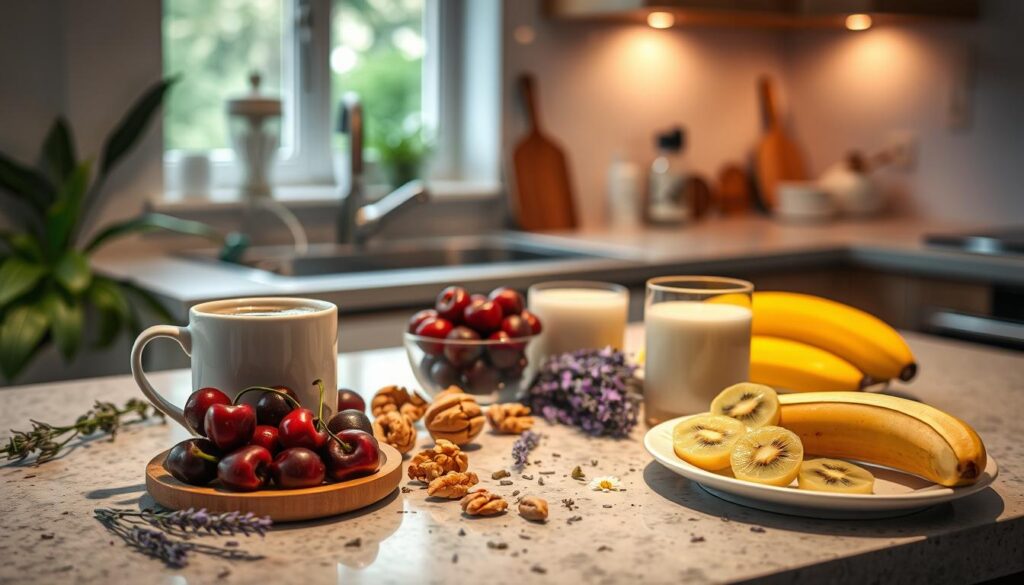
Sleep nutrition is key for quality rest. Some foods help you fall asleep faster and sleep better. Knowing which foods relax you can change your bedtime routine.
Tryptophan-rich foods are great for sleep. Turkey, fish, and dairy have this amino acid. It helps make serotonin, a key sleep neurotransmitter. Eating these foods can help your body get ready for sleep.
“Food is not just fuel, but a powerful tool for sleep optimization” – Sleep Nutrition Experts
Top Sleep-Promoting Foods
- Cherries (natural melatonin source)
- Bananas (potassium and magnesium)
- Almonds (muscle relaxation minerals)
- Dairy products (calcium and tryptophan)
- Whole grain crackers with lean cheese
Herbal teas like chamomile and mint are great for sleep. They calm your nervous system and get your body ready for rest.
[lasso id=”10″ link_id=”167″ type=”table”]
Evening Snack Recommendations
- Peanut butter on whole grain bread
- Fortified cereal with milk
- Small serving of yogurt
- Handful of almonds
Research shows that complex carbs and moderate protein help sleep. Avoid sugary and caffeine-rich foods before bed. They can mess up your sleep cycle.
Everyone reacts differently to foods. Try different sleep-friendly foods to find what works for you.
9 Physical Exercise and Sleep Quality
Physical activity is key to better sleep and overall health. Knowing how exercise and sleep connect helps people sleep better at night.

Studies reveal that regular exercise boosts sleep. Adults who move for 30 minutes a day sleep 15 minutes more than those who don’t.
Best Time for Exercise
When you exercise matters a lot for sleep. Different times have different benefits:
- Morning workouts help set your body clock
- Afternoon exercises can lower stress and calm you down
- Evening workouts are good if done 1-2 hours before bed
Types of Exercise for Better Sleep
Not every workout is good for sleep. Here are some top picks:
| Exercise Type | Sleep Benefits | Recommended Duration |
|---|---|---|
| Aerobic Exercise | Increases slow wave sleep | 30 minutes, 3-5 times weekly |
| Yoga | Reduces stress and promotes relaxation | 20-45 minutes daily |
| Walking | Low-impact, improves overall sleep quality | 30 minutes most days |
“Exercise is the single most powerful tool you have to optimize your brain function and sleep quality.” – Dr. Matthew Walker, Sleep Researcher
Aerobic exercise, like brisk walking, is great for sleep. It’s best for those with insomnia. Regular exercise cuts down on how long it takes to fall asleep and how often you wake up at night.
Everyone is different. Find what exercise schedule and type works best for you.
10 Managing Evening Screen Time
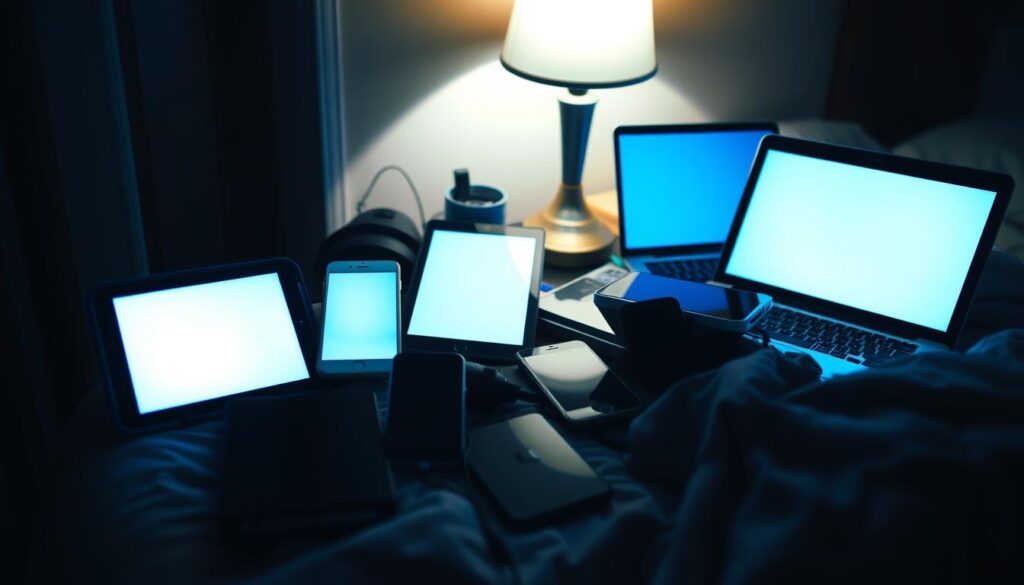
Digital devices are a big part of our lives. But, they can hurt our sleep quality. The blue light from screens messes with our sleep-wake cycle. This makes it hard to fall asleep and get good rest.
Research shows some scary facts about digital devices and sleep:
- 90% of people use screens right before bed
- Screen time can cut melatonin production by up to 50%
- About 67% of adults say they don’t sleep well because of screens at night
The science behind blue light is key. Screens give off a wavelength that lowers melatonin production. Melatonin is the hormone that helps us sleep. This can make it take 30 to 60 minutes longer to fall asleep. It messes with our natural sleep cycle.
“Your bedroom should be a sanctuary for sleep, not a digital playground.” – Sleep Experts
Here are some ways to handle evening screen time:
- Set a digital curfew 1-2 hours before bed
- Use apps or settings that filter out blue light
- Keep devices out of your bedroom
- Swap screen time for relaxing activities like reading
By using these tips, you can cut down on blue light and make your bedroom better for sleep. Remember, how you use digital devices affects your sleep.
11 Stress Management Before Bedtime
Stress and sleep are closely linked, affecting our rest. About 60% of adults say stress hurts their sleep. It’s important to learn how to manage anxiety for better sleep.
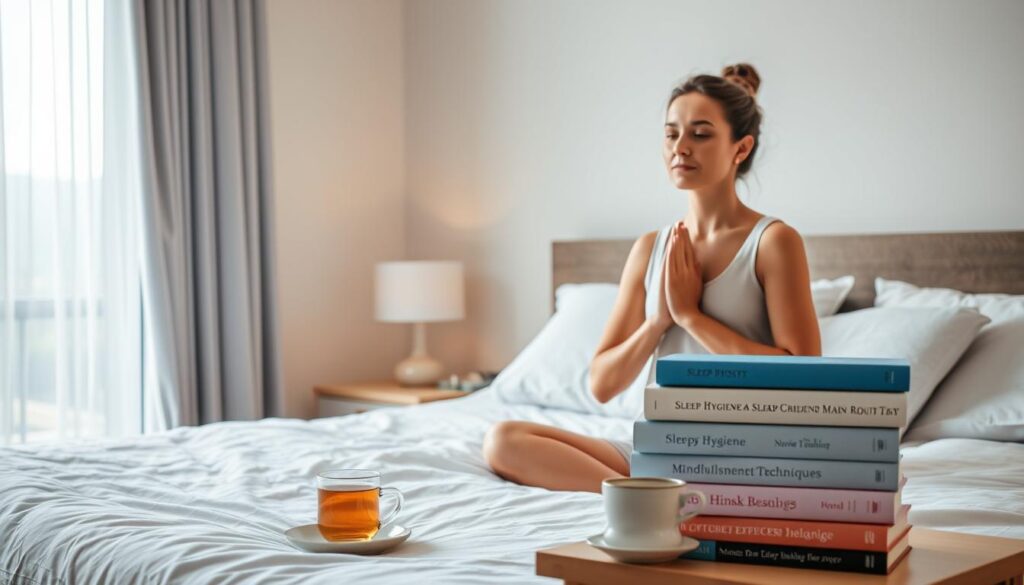
Stress can mess up our sleep patterns, making it hard to relax at night. But, there are ways to handle stress and calm down before bed.
Journaling Techniques for Emotional Release
Journaling is a great way to reduce stress. Studies show it can lower anxiety by about 35%. Here are some journaling tips:
- Gratitude journaling: List 3-5 good things from the day
- Worry dump: Write down worries to clear your mind
- Goal reflection: Think about and adjust your goals
Anxiety Reduction Methods
Using specific techniques can change your bedtime routine. Deep breathing and muscle relaxation are effective in calming down and getting ready for sleep.
“The art of relaxation is the foundation of a peaceful night’s rest.” – Sleep Wellness Expert
- Practice 4-7-8 breathing technique
- Do some gentle stretching
- Use guided meditation apps
- Make a calming bedtime ritual
By using these strategies, you can improve your sleep. Being consistent is important to create a routine that tells your body it’s time to relax.
12 Natural Sleep Aids and Supplements

Over 60 million Americans struggle with sleep quality. This has led many to look into natural sleep supplements and remedies for insomnia. Finding the right natural aids can greatly improve your sleep without the need for drugs.
Many natural sleep supplements have been backed by science. They show great promise in helping you sleep better:
- Melatonin: A hormone made by the brain, it helps control sleep and wake cycles
- Valerian root: It helps you fall asleep faster and sleep better
- Magnesium: It relaxes muscles and helps with sleep
- Lavender: It has calming effects through aromatherapy
Research shows that melatonin supplements can be very effective. Studies suggest that doses of 3-10 mg can improve sleep quality. Fast-release melatonin might work better than slow-release.
“Natural sleep aids provide a gentler approach to managing sleep challenges compared to pharmaceutical alternatives.” – Sleep Research Institute
[lasso id=”6″ link_id=”168″ type=”table”]
When looking at sleep supplements, remember these important tips:
- Always talk to a healthcare professional before starting any supplement
- Start with small doses to see how your body reacts
- Watch how your body responds to different natural remedies for insomnia
- Use supplements along with good sleep habits
Note: The FDA does not pre-approve dietary supplements. So, it’s crucial to do your research and get professional advice.
13 Creating an Effective Bedtime Routine
Creating a consistent sleep routine is key for quality rest and health. A good bedtime routine can make your sleep better and help your body’s clock stay in sync.
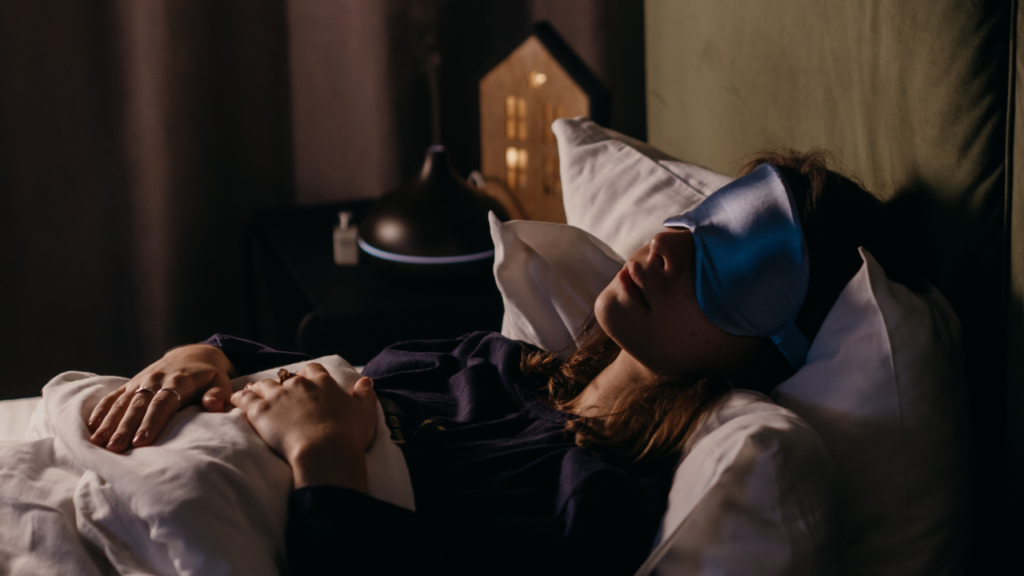
To set a consistent sleep schedule, you need to plan and stick to it. Studies show that keeping the same bedtime and wake-up time can greatly improve your sleep.
Timing Your Sleep Schedule
For the best sleep, consider these important points:
- Aim for 7-8 hours of sleep each night
- Choose a consistent bedtime and wake-up time
- Don’t nap after 3:00 PM
- Have a calm evening routine
Pre-Sleep Rituals
Good pre-sleep rituals tell your body it’s time to sleep. Here are some tips backed by science:
- Take a warm bath an hour before bed
- Do some light stretching or meditation
- Write down your plans for tomorrow
- Listen to soothing music or sounds
“A consistent bedtime routine can train your brain to feel naturally tired,” experts suggest.
| Activity | Duration | Sleep Impact |
|---|---|---|
| Warm Bath | 20-30 minutes | Induces drowsiness |
| Meditation | 10-15 minutes | Reduces anxiety |
| Journaling | 5-10 minutes | Clears mental clutter |
By using these sleep routine tips, you can build a strong bedtime routine. This will help you stick to a consistent sleep schedule and improve your sleep quality.
14 Common Sleep Disruptors to Avoid
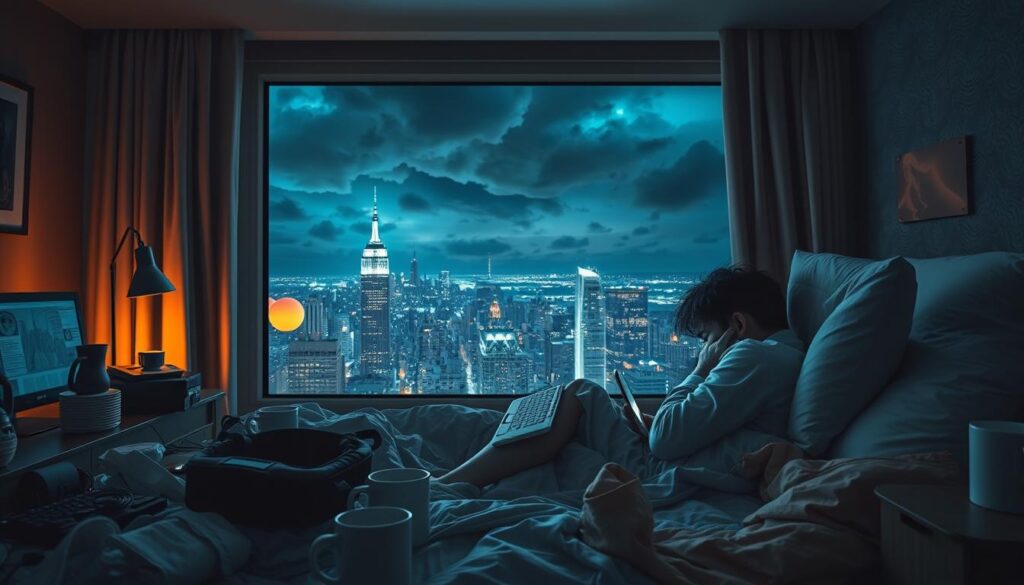
Knowing about sleep hygiene means spotting common sleep problems. Lifestyle choices and substances can mess with your sleep. They can make it hard to fall asleep and keep sleep quality up.
“Sleep is not a luxury, it’s a biological necessity” – Dr. Matthew Walker
Many things can cause insomnia and mess with your sleep cycle. Here are the main sleep disruptors to watch out for:
- Caffeine consumption within 6 hours of bedtime
- Alcohol consumption before sleeping
- Nicotine and tobacco products
- Irregular sleep schedules
- Electronic device usage before bed
About 20% of adults struggle with sleep disruptions. These problems come from many places, like lifestyle, health issues, and the environment.
Some medicines can also mess with sleep. Antidepressants, blood pressure meds, and pain relievers might change how you sleep. It’s important to talk to a doctor about sleep side effects.
Shift workers have special sleep problems. About 30% of adults face sleep issues because of their work schedules. This can really mess with their body’s natural sleep rhythm.
To tackle these sleep problems, start with regular sleep routines. Manage stress and make your sleep space the best it can be. By understanding and tackling these issues, you can greatly improve your sleep hygiene and rest quality.
15 When to Seek Professional Help

Knowing when to get help for sleep problems is key for your health. About 30% of adults have insomnia symptoms. This is a big issue that can’t be ignored.
When signs of sleep disorders last a long time, it’s time to see a professional. These issues can really hurt your life and might show other health problems.
Key Indicators You Need Professional Sleep Intervention:
- Persistent insomnia lasting more than four weeks
- Excessive daytime sleepiness affecting work performance
- Irregular breathing or loud snoring during sleep
- Frequent nighttime awakenings
- Overwhelming fatigue that disrupts daily activities
Getting diagnosed for insomnia usually means seeing a sleep specialist. They will check you out thoroughly. This might include:
| Diagnostic Method | Purpose |
|---|---|
| Sleep Diary | Track sleep patterns for 1-2 weeks |
| Polysomnography | Overnight sleep study monitoring brain waves and body functions |
| Medical History Review | Assess potential underlying health conditions |
*”Early intervention can prevent long-term sleep complications and improve overall health outcomes.”*
Therapists might suggest Cognitive Behavioral Therapy (CBT) for sleep issues. Studies show CBT can cut insomnia symptoms by half in people with mental health issues.
If sleep problems keep coming back, talk to a doctor. With the right treatment, you can get back to sleeping well and feeling better overall.
16 Conclusion
Improving sleep quickly needs a whole-body approach. Small, smart changes can greatly improve sleep quality. Understanding lifestyle, environment, and body processes helps create sleep plans that fit each person.
Success in sleep comes from trying new things and sticking to them. Adjusting your room, using breathing exercises, or limiting screen time all help. Studies show that methods like the 4-7-8 breathing, mindfulness, and cool rooms can greatly improve sleep.
Dr. Devon Hoffman says learning good sleep habits early is key. As we get older, sleep problems grow. Using proven strategies can help avoid long-term sleep issues. It’s about building lasting sleep habits, not just quick fixes.
Your path to better sleep is unique and ongoing. While no one technique fits all, this guide offers many tools. Be patient, open to change, and see sleep as a key part of your health.










